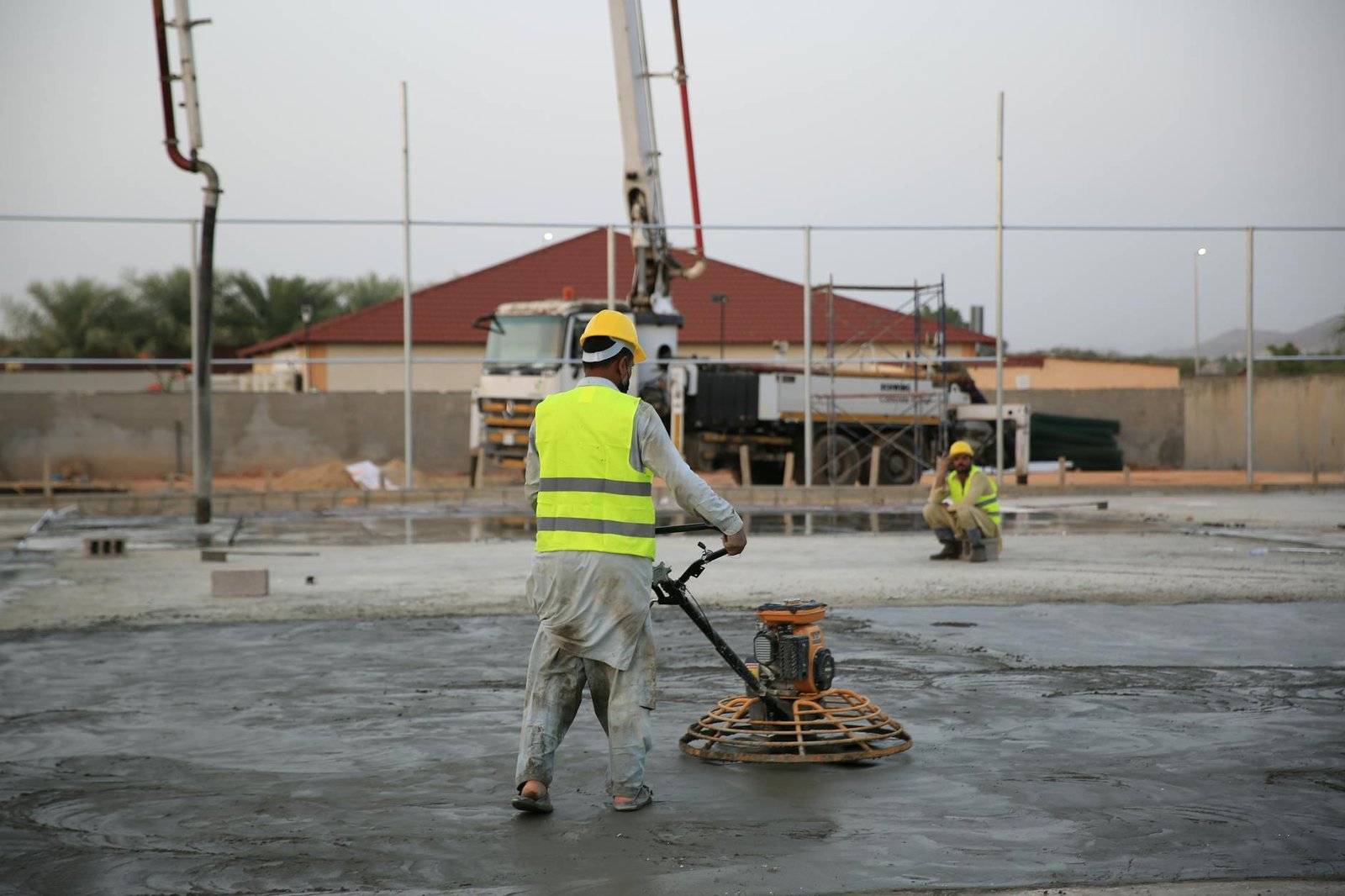
Concrete Work Safety: Hazards and Control Measures
1. Introduction to Concrete Work Hazards
Concrete work is fundamental across construction, oil & gas, and manufacturing industries, involving mixing, pouring, finishing, and curing operations. While essential for structural integrity, these activities present numerous safety hazards that can cause severe injuries or fatalities if not properly managed. This comprehensive guide examines concrete work hazards and provides detailed control measures to enhance workplace safety.
2. Common Concrete Operations
- Batching and Mixing
- Transporting and Placing
- Compacting and Leveling
- Finishing and Curing
- Formwork Installation/Removal
- Concrete Cutting and Drilling
- Sprayed Concrete Applications
- Repair and Demolition
3. Major Hazards in Concrete Work
A. Physical Hazards
- Skin Burns and Irritation
- Wet concrete is highly alkaline (pH 12-13)
- Causes severe chemical burns (cement dermatitis)
- Eye Injuries
- Cement dust or splashes during mixing
- Projectiles during cutting/drilling
- Noise Exposure
- Concrete saws (110-120 dB)
- Vibrators and mixers
- Vibration Hazards
- Prolonged use of power trowels
- Hand-arm vibration syndrome (HAVS)
- Struck-by Injuries
- Falling tools or formwork
- Rebounding concrete chunks
B. Chemical Hazards
- Silica Exposure
- Cutting/drilling generates respirable crystalline silica
- Causes silicosis and lung cancer
- Hexavalent Chromium
- Present in wet cement
- Causes allergic contact dermatitis
- Admixture Chemicals
- Superplasticizers, accelerators
- Respiratory and skin hazards
C. Ergonomic Hazards
- Heavy Lifting
- Bagged cement (40-50 kg each)
- Rebar and formwork materials
- Awkward Postures
- Kneeling during finishing
- Overhead work
- Repetitive Motions
- Troweling operations
- Rebar tying
D. Environmental Hazards
- Heat Stress
- Working with hot concrete in summer
- Dehydration and heat stroke
- Cold Stress
- Pouring in freezing temperatures
- Frostbite risks
- Confined Spaces
- Working in concrete vaults or pits
- Oxygen-deficient atmospheres
E. Structural Hazards
- Formwork Collapse
- Inadequate bracing
- Premature stripping
- Fresh Concrete Falls
- Working under concrete placement
- Bucket handling accidents
- Rebar Impalement
- Unprotected protruding bars
- Fall hazards near rebar mats
4. Control Measures for Concrete Work
A. Engineering Controls
- Wet Cutting Methods
- Water suppression for saws
- HEPA vacuum systems
- Dust Collection Systems
- For mixing and batching plants
- Enclosed processing areas
- Mechanical Aids
- Concrete pumps
- Power buggies
- Vacuum lifters for bags
- Formwork Safety
- Engineered shoring systems
- Load monitoring devices
B. Administrative Controls
- Work Rotation
- Limit exposure to vibration/noise
- Heat stress management
- Training Programs
- Silica awareness
- Proper lifting techniques
- Emergency procedures
- Job Planning
- Pre-pour safety meetings
- Concrete placement sequencing
- Medical Surveillance
- Audiometric testing
- Silica health monitoring
C. Personal Protective Equipment (PPE)
- Skin Protection
- Alkali-resistant gloves
- Waterproof boots
- Full-coverage clothing
- Eye/Face Protection
- Tight-fitting goggles
- Faceshields for cutting
- Respiratory Protection
- N95 for dust
- PAPR for silica work
- Hearing Protection
- Earplugs (NRR 25+)
- Earmuffs for loud areas
D. Safe Work Practices
- Concrete Handling
- Never stand in fresh concrete
- Use proper lifting techniques
- Tool Safety
- GFCI for electric tools
- Regular equipment inspections
- Housekeeping
- Prompt spill cleanup
- Proper waste disposal
- Emergency Preparedness
- Eye wash stations
- Chemical burn protocols
5. Industry-Specific Considerations
A. Construction Sector
- Challenge: Mobile concrete operations
- Solution: Dedicated mixing areas
- Special Risk: Working at heights with concrete
B. Oil & Gas Industry
- Challenge: Concrete in classified areas
- Solution: Intrinsically safe equipment
- Special Risk: Sulfide exposure in foundations
C. Manufacturing Facilities
- Challenge: Repair work during production
- Solution: Non-shrink rapid-set materials
- Special Risk: Chemical contamination
6. 10 Frequently Asked Questions (FAQs)
FAQ 1: How long does wet concrete remain hazardous?
Answer:
- Chemical burn risk lasts until fully cured (24-48 hrs)
- Wear protection until surface is dry and hard
FAQ 2: What first aid is needed for concrete burns?
Answer:
- Flush with pH-neutral solution
- Remove contaminated clothing
- Seek medical attention immediately
FAQ 3: How to control silica dust when cutting?
Answer:
- Use water-fed saws
- HEPA vacuum attachment
- Respiratory protection
- Containment barriers
FAQ 4: What are the risks of aluminum finishing tools?
Answer:
- Hydrogen gas generation
- Explosion hazard in confined spaces
- Use non-sparking tools instead
FAQ 5: How to safely handle concrete in cold weather?
Answer:
- Use heated enclosures
- Calcium chloride accelerators
- Insulated blankets
- Monitor temperature thresholds
FAQ 6: What are the electrical hazards in concrete work?
Answer:
- Damaged cords in wet areas
- Overhead power lines
- GFCI protection essential
- Equipment grounding
FAQ 7: How to prevent rebar impalement?
Answer:
- Install protective caps
- Barricade work areas
- Fall protection near rebars
- Use foam covers
FAQ 8: What PPE is needed for spraying concrete?
Answer:
- Air-supplied respirator
- Full face protection
- Waterproof clothing
- Hearing protection
FAQ 9: How to safely strip formwork?
Answer:
- Follow engineered sequence
- No workers under suspended loads
- Proper bracing during removal
- Confirm concrete strength first
FAQ 10: What are the environmental concerns with concrete?
Answer:
- Runoff pH control
- Silica dust containment
- Washout management
- Sustainable mix designs
7. Conclusion
Effective concrete work safety requires:
✔ Comprehensive hazard awareness
✔ Proper engineering controls
✔ Adequate PPE selection
✔ Continuous training
✔ Strict adherence to safe practices
By implementing these measures across industries, organizations can significantly reduce concrete-related injuries while maintaining productivity. Regular safety audits and worker engagement ensure continuous improvement in concrete operations safety.
Plumbing Work Safety: Hazards and Control Measures
Formwork Safety: Hazards and Control Measures
Painting Work Safety: Hazards and Control Measures